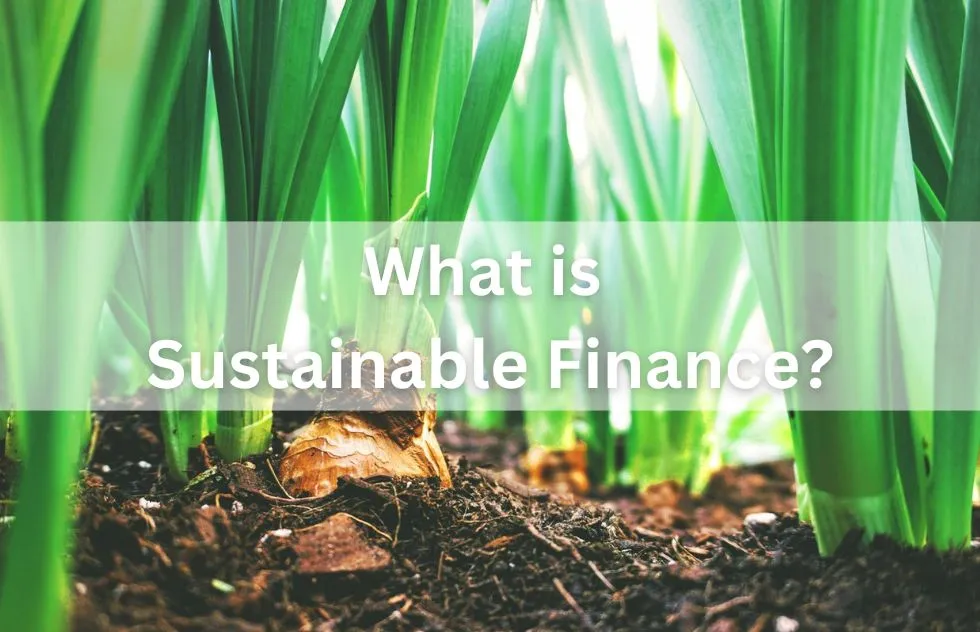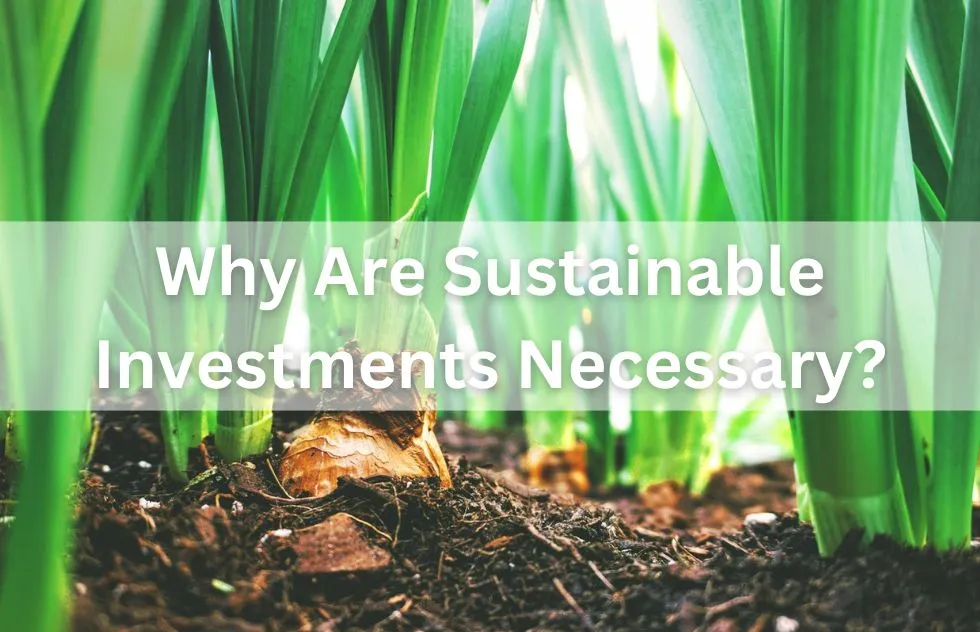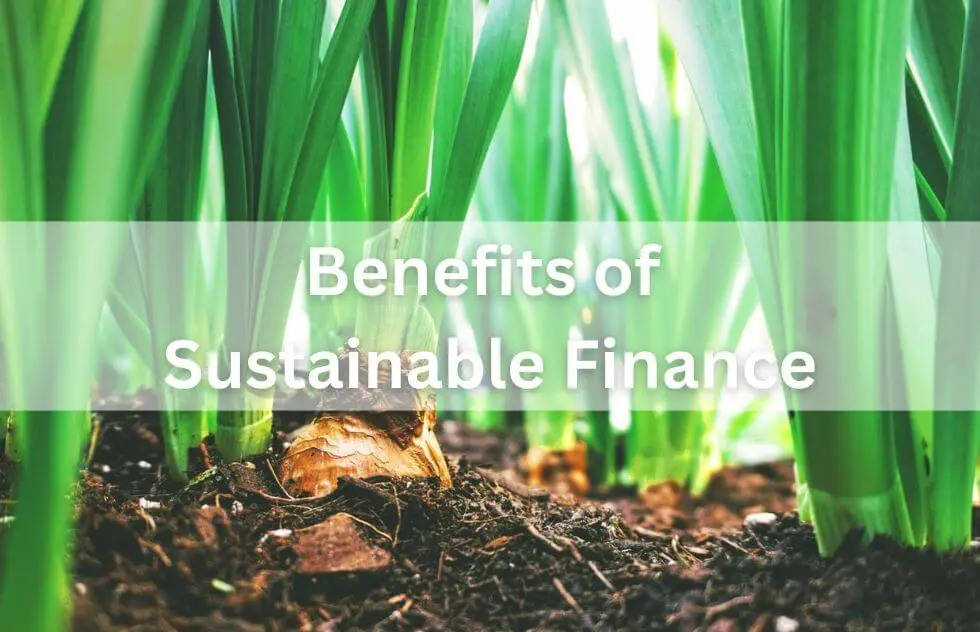In a world increasingly facing the challenges of climate change and social inequality, sustainable finance is becoming ever more important. Investments have the power not only to create wealth but also to drive social and environmental change. This article explores what sustainable finance entails, why it is necessary, and how individuals and institutions can contribute.

What is Sustainable Finance?
Sustainable finance is a growing field within the financial sector that involves integrating environmental, social, and governance (ESG) criteria into investment and financing decisions. This approach goes beyond the traditional goals of the financial world—profit maximization and short-term returns—and considers the long-term impacts on the environment and society.
Definition and Core Principles
Sustainable finance encompasses strategies aimed at directing capital into projects, companies, or funds that are not only financially profitable but also contribute positively to society and the planet. This is achieved by addressing ecological factors such as reducing CO₂ emissions, conserving natural resources, and protecting biodiversity. At the same time, social issues like fair working conditions, diversity and inclusion, and the protection of human rights are part of the evaluation process. The third pillar, governance, focuses on transparency and ethical corporate management, including combating corruption and promoting equality in leadership positions.
The core principles of sustainable finance can be summarized as follows:
- Long-Term Perspective: Considering the long-term effects of financial decisions on the environment and society.
- Responsibility: Investors and companies taking accountability for the social and environmental consequences of their activities.
- Inclusion: Integrating ESG criteria into decision-making processes to gain a broader understanding of risks and opportunities.
The Connection Between Sustainability and Economics
Sustainability and profitability are often seen as opposites, but in reality, they can complement each other. Companies that implement sustainable practices benefit not only from an improved reputation but also from lower operating costs and stronger customer loyalty. For example, energy-efficient production methods save costs, while the use of renewable energy mitigates long-term price fluctuations in fossil fuels.
There are also tangible benefits for investors: studies show that companies meeting ESG criteria are less prone to scandals or regulatory risks. This makes sustainable investments more resilient to market fluctuations and more crisis-resistant. A focus on sustainability can thus deliver not only ethical but also financial advantages.
A New Approach in the Financial World
Traditional financial systems often prioritize short-term returns without considering the long-term impacts on the environment and society. Sustainable finance challenges this paradigm and offers an alternative perspective: it aims to direct capital flows in ways that create positive impacts while achieving financial goals.
One example is “mission-driven investment,” where capital is specifically allocated to projects with a sustainable mission, such as the development of renewable energy or supporting startups that create innovative solutions to global challenges. These approaches are not just ethical statements but also responses to the growing demand from consumers and investors for responsible financial products.
Why Sustainable Finance Is Becoming Increasingly Important
The urgency to make the financial world more sustainable stems from two main factors: first, climate change is increasingly recognized as a systemic risk that can destabilize markets. Second, an increasing number of investors—both institutional and private—demand products that not only yield financial returns but also align with their personal values.
Additionally, political initiatives such as the EU Taxonomy are setting new standards for sustainable financial practices. These regulatory frameworks define what qualifies as “green” or sustainable, creating a unified understanding. These developments show that sustainable finance is no longer a niche topic but is increasingly shaping the direction of global financial markets.

Why Are Sustainable Investments Necessary?
Sustainable investment is not just a trend but an urgent necessity to address the pressing challenges of our time. Climate change, social inequality, and unethical business practices threaten not only the environment and society but also the stability and efficiency of the global economy. Sustainable investments offer an opportunity to strategically allocate capital to address these issues while ensuring financial stability and returns.
The Impact of Climate Change on the Economy
Climate change is one of the greatest risks to the global economy. Extreme weather events such as heatwaves, floods, and storms are increasing in both frequency and intensity. The economic costs of these disasters are enormous: buildings, infrastructure, and crops are destroyed, resulting in damages worth billions. In 2021 alone, the economic damages from natural disasters worldwide exceeded $280 billion.
Furthermore, climate change affects entire economic sectors. Agriculture suffers from crop failures due to droughts, while the insurance industry faces rising claims. Even seemingly unrelated sectors like technology could be severely impacted by higher energy costs or disrupted supply chains.
Sustainable investments can play a critical role here by channeling capital into climate-friendly technologies and infrastructure projects. These investments not only help mitigate the adverse effects of climate change but also create new economic opportunities. For example, promoting renewable energy has created jobs in many countries and reduced dependence on fossil fuels.
Social and Ethical Responsibility of Investors
Investors have a societal responsibility that goes beyond mere profit maximization. In a globalized world, businesses and investors are closely linked to society, and their decisions affect the quality of life for millions. Sustainable investment provides an opportunity to consciously use capital to address social issues such as inequality, poverty, and unfair working conditions.
One example is the promotion of education and healthcare. Impact investments in education programs can improve workforce qualifications and foster social mobility over the long term. Investments in the healthcare sector strengthen infrastructure and ensure better access to services, even in underserved regions.
Beyond moral obligations, there are also pragmatic reasons for sustainable investments. Social problems like inequality or human rights violations can pose significant economic risks. These issues often lead to political instability, consumer boycotts, or legal disputes that can be costly for businesses. By promoting ethical business practices, investors can uphold moral values while also minimizing risks.
The Role of Capital in Addressing Global Challenges
Capital is a powerful tool for driving change. When used effectively, investments can play a vital role in tackling global challenges by channeling funds into projects and companies that promote sustainable innovations or provide solutions to existing problems.
A strong example is the funding of carbon reduction technologies. Companies developing innovative solutions often require significant initial investments to bring their products to market. Investors supporting these businesses enable faster scaling of technologies, thereby contributing more effectively to combating climate change.
Another example is the development of a circular economy, where waste is reused as a resource. Sustainable investments in companies creating recycling solutions or startups developing alternative materials for environmentally harmful products not only yield ecological benefits but also open up new markets.
The Growing Demand for Responsible Financial Products
More institutional and private investors are recognizing the importance of sustainable investments. Studies show that younger generations, such as Millennials and Generation Z, increasingly value aligning their financial decisions with their personal values. They seek not only returns but also the assurance that their money is making a positive impact.
This demand has driven the rise of sustainable financial products, such as Green Bonds, ESG funds, and Impact Investments. At the same time, investors are pressuring companies to adopt more sustainable practices. For instance, the “Climate Action 100+” initiative—a coalition of global investors—urges major corporations to implement measures to reduce their carbon emissions.
Long-Term Stability and Resilience Through Sustainable Investments
An often overlooked aspect of sustainable investments is their resilience during market crises. Companies that adhere to ESG criteria are typically better prepared for regulatory changes or shifts in consumer expectations. They are less prone to scandals or sanctions, as they operate with greater transparency and ethical standards.
Furthermore, sustainable investments enhance portfolio diversification. By including companies in industries such as renewable energy, water management, or sustainable agriculture, investors can better spread risks and shield themselves from the impacts of traditional market fluctuations.
Sustainable investments are essential because they bridge ethical considerations with economic necessities. They help address challenges like climate change and social inequality while offering stable returns and long-term economic benefits. Through the strategic allocation of capital, investors can contribute to solving global problems and help create a livable world for future generations.

Forms of Sustainable Investments
Sustainable investments provide diverse opportunities to use capital not only for financial returns but also for social and environmental purposes. Investors can choose from a variety of approaches that reflect different priorities and goals. The main forms of sustainable investments include ESG investments, Green Bonds, and Impact Investing. Each of these categories has its own characteristics and benefits that help investors achieve their individual objectives.
ESG Investments: What They Are
ESG investments are based on the consideration of Environmental, Social, and Governance (ESG) criteria in selecting investment opportunities. These criteria provide a framework for evaluating and identifying companies that operate sustainably and act responsibly.
- Environmental: Focuses on companies that invest in renewable energy, protect water resources, or minimize the ecological footprint of their production. Examples include solar and wind energy companies or businesses specializing in sustainable forestry.
- Social: Concerns how companies interact with employees, supply chains, and the communities they operate in. Positive examples are companies that pay fair wages, promote diversity, or support charitable initiatives.
- Governance: Encompasses corporate governance and oversight. ESG investors prefer companies with transparent structures that combat corruption and ensure responsible corporate management.
A concrete example of ESG investments is specialized funds that include only companies with high ESG ratings in their portfolios. These ratings are provided by independent agencies that assess a company’s sustainability performance. This ensures that investors’ capital is allocated to businesses that share their values and standards.
Green Bonds and Their Significance
Green Bonds are one of the most popular forms of sustainable investments and are specifically designed to finance projects with positive environmental impacts. They are traditional fixed-income securities whose proceeds are exclusively used for green projects. Such projects can include:
- Renewable Energy: Construction of solar farms, wind power plants, or geothermal projects.
- Sustainable Infrastructure: Development of energy-efficient buildings, sustainable transportation systems, or waste management solutions.
- Conservation Projects: Reforestation, biodiversity protection, and clean water initiatives.
Green Bonds offer investors not only a financial return but also the chance to make a direct contribution to combating climate change. A notable example is the European Investment Bank’s bond, which finances offshore wind farms and other green projects. As demand for these bonds grows, they play a crucial role in mobilizing capital for environmentally friendly projects.
Impact Investing: More Than Just Returns
Impact investing goes beyond ESG investments, aiming to achieve measurable positive impacts on society and the environment while also generating financial returns. It is particularly appealing to investors who want to play an active role in addressing global challenges.
- Social Impact: Examples include investments in education programs, affordable housing projects, or microfinance initiatives that provide access to credit for people in developing countries.
- Environmental Impact: Projects such as ecosystem restoration, sustainable agriculture, or technologies to reduce plastic pollution are common areas of focus.
A concrete example of impact investing is supporting social enterprises that develop innovative solutions to issues like poverty or access to clean water. Investors not only provide capital but also foster direct, positive changes that are often measurable—for example, the number of children supported through education programs or the amount of CO₂ emissions reduced by a project.
Thematic Investments: Focus on Key Issues
Thematic investments are another tool for sustainable investors who want to focus on specific themes or industries. These investments align with long-term megatrends shaping the global economy:
- Climate and Energy: Investments in companies developing technologies to reduce greenhouse gas emissions or promote clean energy sources.
- Water Management: Support for projects aimed at sustainable water use and recycling.
- Healthcare: Capital for companies developing affordable medications or ensuring medical care in remote regions.
Thematic investments allow investors to focus on a specific cause they care deeply about, combining personal values with financial goals.
Sustainable ETFs and Index Funds
Sustainable exchange-traded funds (ETFs) and index funds provide a cost-effective way to invest in a wide range of sustainable companies. These funds often track specific sustainability indices, such as the MSCI ESG Leaders Index or the FTSE4Good Index, offering broad diversification.
- Advantages of ETFs: These funds are transparent, liquid, and provide an easy way to incorporate ESG criteria into a portfolio.
- Sustainability Filters: ETFs often exclude companies involved in controversial industries such as fossil fuels, weapons production, or tobacco.
Sustainable ETFs are particularly popular among retail investors, as they offer low-effort access to sustainable investments.
Community Investments and Crowdfunding
Community investments and crowdfunding are additional forms of sustainable investing, particularly attractive to small-scale investors. These approaches allow individuals to directly fund local or specific projects, such as:
- Renewable Energy: Financing solar installations for communities or cooperative wind farms.
- Social Projects: Supporting educational programs or social initiatives through platforms like Startnext or Kickstarter.
This type of investment gives investors the opportunity to build a closer connection with the projects they support and often receive direct feedback on their success.
Why the Diversity of Sustainable Investments Matters
The various forms of sustainable investing allow investors to align their individual values and goals with financial success. Whether the aim is to reduce CO₂ emissions, promote social justice, or build a stable long-term portfolio, the broad range of options makes sustainable investing accessible to everyone.
By combining these approaches, investors can achieve their financial goals while contributing positively to solving global challenges. Sustainable investing is, therefore, a powerful tool to steer the economy and society toward a greener and more equitable future.

Benefits of Sustainable Finance
Sustainable finance offers a wide range of benefits encompassing economic, social, and environmental aspects. It demonstrates that responsible financial decisions can be both morally right and economically sound. Below are the key advantages of sustainable finance, highlighting the importance of this approach.
Long-Term Stability and Returns
One of the greatest advantages of sustainable finance is its resilience during market crises. Companies that meet ESG (Environmental, Social, and Governance) criteria often exhibit greater long-term stability. Studies show that sustainable portfolios were less affected during economic turbulence, such as the COVID-19 pandemic. This can be attributed to:
- Crisis Resilience: Companies that account for environmental and social risks are better prepared for unforeseen challenges.
- Regulatory Compliance: Sustainable companies typically adhere to stricter regulations and are less prone to legal or regulatory issues.
- Risk Mitigation: ESG-focused companies avoid problematic business practices that could lead to scandals or boycotts.
Furthermore, sustainable investments often deliver returns comparable to or even better than conventional investments. This disproves the misconception that responsible investing compromises profitability. Investors benefit from a combination of financial security and ethical responsibility.
Positive Impact on Society and the Environment
Sustainable finance actively contributes to positive global change by channeling capital into projects that address social and environmental challenges. Examples include:
- Environmental Protection: Investments in renewable energy, reforestation projects, or clean technologies help combat climate change and preserve nature.
- Promoting Social Justice: Sustainable finance strategies support companies that create fair working conditions, promote diversity, and provide dignified employment opportunities.
- Community Empowerment: Projects focused on infrastructure development, education, and healthcare improve the quality of life in underserved regions.
This positive impact extends beyond individual investments, contributing to the resolution of global issues. By investing in sustainable projects, innovation is fostered, addressing not only current problems but also preparing for future challenges.
Enhanced Risk Management
Sustainable financial strategies account for a broader range of risks that are often overlooked in traditional approaches. ESG criteria help identify and address potential issues early, preventing them from escalating into major challenges. Examples include:
- Environmental Risks: Companies ignoring climate change may face rising costs for emissions permits, stricter regulations, or declining demand in the future. Sustainable companies that focus on renewable energy and resource efficiency are better prepared for such scenarios.
- Reputation Risks: Scandals involving human rights violations or environmental damage can cause lasting harm to a company’s reputation. ESG-focused companies minimize these risks through transparent and ethical business practices.
- Market Risks: Sustainable companies are often more diversified and innovative, making them more resilient to market changes.
Investors who adopt sustainable financial strategies benefit from more comprehensive risk management and better adaptability to change.
Attractiveness to Investors and Customers
Sustainability is becoming a key factor for investors, customers, and employees. Companies that operate sustainably attract more capital as they are perceived as responsible and forward-thinking. This trend is driven by several factors:
- Demand for ESG Products: Increasing numbers of institutional and retail investors seek financial products that align with their values.
- Customer Loyalty: Consumers prefer brands that act ethically and contribute to society. Sustainable companies often enjoy higher customer retention and brand loyalty.
- Attractiveness as Employers: Talented individuals, especially from younger generations, favor companies that take sustainability and social responsibility seriously.
Integrating sustainability not only strengthens a company’s market position but also enhances its appeal to all relevant stakeholders.
Promoting Innovation
Sustainable financing approaches foster innovation by directing capital toward forward-looking technologies and solutions. Companies involved in renewable energy, recycling, circular economy, or other sustainable business models often rely on investments to bring their ideas to life. This support results in:
- Technological Advancement: Funding for companies developing technologies for CO₂ reduction, water treatment, or sustainable agriculture.
- New Business Opportunities: Sustainable investments open up new markets, driven by the growing demand for green products and services.
- Long-Term Competitiveness: Companies that invest early in sustainability position themselves as pioneers, securing long-term competitive advantages.
By encouraging innovation, sustainable finance plays a crucial role in transforming economies and societies.
Supporting Global Sustainable Development Goals (SDGs)
The United Nations has outlined 17 Sustainable Development Goals (SDGs) to be achieved by 2030. Sustainable finance is critical to reaching these goals by channeling capital into areas like clean energy, education, equality, and poverty reduction. Examples include:
- SDG 7 (Affordable and Clean Energy): Investments in solar and wind power contribute to reducing CO₂ emissions.
- SDG 4 (Quality Education): Funding educational projects improves access to knowledge and skills.
- SDG 13 (Climate Action): Supporting initiatives for climate adaptation and mitigation.
Sustainable investments accelerate the implementation of the SDGs, benefiting both the global community and investors in the long term.
A Sustainable Contribution for Future Generations
Sustainable finance helps create a fairer and more livable world for future generations. It is a tool to minimize environmental damage, combat social inequalities, and build a resilient economy. Through sustainable investments, investors can actively contribute to ensuring that future generations live in a stable, healthy, and sustainable environment.
In summary, sustainable investments offer benefits that go far beyond financial returns. They combine ethical values with economic success, drive innovation, and address global challenges. By minimizing risks, maximizing opportunities, and positively impacting the world, sustainable finance is a win-win strategy for both investors and society.

Challenges and Criticisms
Despite the growing interest in and evident benefits of sustainable finance, there are significant challenges to overcome. Investors and companies face several obstacles in effectively implementing sustainable financial strategies. Additionally, there is criticism that not all approaches are as effective or transparent as they should be. This section examines the key challenges and controversies associated with sustainable finance.
Greenwashing: A Threat to Trust and Effectiveness
One of the biggest challenges in sustainable finance is the phenomenon of greenwashing. This occurs when companies or financial products are marketed as sustainable, even though they are not. Greenwashing can be intentional, aiming to capitalize on the growing demand for ESG investments, or unintentional, due to the often ambiguous definition of sustainability.
Examples of Greenwashing:
- Some companies publish reports that exaggerate their sustainability efforts or omit significant negative aspects. For instance, oil and gas companies may highlight their minimal investments in renewable energy while continuing to heavily invest in fossil fuels.
Impacts:
- Greenwashing undermines the trust of investors and consumers in sustainable financial products.
- It makes it harder to identify and reward genuine progress, reducing the effectiveness of the entire approach.
Strategies to Combat Greenwashing:
- Transparency and Standardized Reporting: Clear, measurable goals and regular progress updates are essential to avoid greenwashing.
- Independent Audits: Third-party audits can enhance credibility and ensure that claims align with actual performance.
Addressing greenwashing is critical to maintaining confidence in sustainable finance and ensuring its impact is both genuine and measurable.
Limited Data and Inconsistent Standards
Another challenge is the lack of availability and comparability of data. ESG criteria are complex and not uniformly defined, making objective evaluations of sustainable investments difficult.
- Inconsistent ESG Ratings:
Different rating agencies use varied methods to evaluate ESG factors, leading to contradictory results. A company rated highly by one agency might receive a poor rating from another.
- Lack of Transparency: Many companies provide insufficient or inconsistent information about their ESG practices, making it challenging for investors to make informed decisions.
- Approaches to Solutions: Authorities are working on developing standards and guidelines for ESG reporting. The EU Taxonomy, for instance, establishes clear criteria for sustainable investments, contributing to greater transparency and comparability.
Costs and Effort for Companies
Implementing sustainable practices can be costly and time-consuming for companies. Smaller businesses, in particular, may lack the resources to develop comprehensive ESG strategies or meet reporting requirements.
- High Entry Barriers:
Building sustainable supply chains or adopting eco-friendly technologies often requires significant upfront investments, which can be burdensome for small and medium-sized enterprises (SMEs).
- Complex Requirements: The variety of reporting standards and certifications can be confusing, requiring substantial time and money to comply.
- Support Options: Financial incentives or technical assistance from governments and international organizations can ease the transition. Subsidies for green technologies or tax relief for sustainable practices are possible measures.
Resistance in Traditional Financial Systems
Traditional financial models are often not designed to integrate sustainable principles. The focus on short-term returns and adherence to established methods hampers the adoption of sustainable financial practices.
- Short-Term Thinking:
Many investors and companies remain focused on short-term profits rather than long-term sustainability goals. This mindset can discourage sustainability initiatives, as their benefits often only become apparent after several years. - Resistance from Decision-Makers:
Managers and investors accustomed to traditional business models may view sustainable financial strategies as risky or unprofitable, leading to slow progress in the industry. - Approaches to Change:
Overcoming resistance requires education and raising awareness. Highlighting success stories of sustainable investments and promoting collaboration between traditional and sustainable financial stakeholders can help break down these barriers.
Lack of Global Collaboration
Sustainable finance is a global challenge, yet coordinated collaboration between countries and markets is lacking. Different political and economic priorities often result in inconsistent regulations and standards.
- Inconsistent Regulations:
While some regions, like the EU, are developing comprehensive standards for sustainable finance, others lag behind. This leads to inconsistencies that can unsettle international investors.
- Competitive Disparities:
Countries or companies implementing stricter sustainability standards might feel disadvantaged compared to regions with more lenient rules. - Promoting Global Collaboration:
Organizations like the UN or G20 could create platforms to harmonize sustainable finance practices. Shared goals and standards would enhance the effectiveness of sustainable investments worldwide.
Criticism of the Effectiveness of Sustainable Finance
Some critics question whether sustainable finance achieves its intended impact. They argue that many ESG initiatives are superficial and fail to drive meaningful change.
- Lack of Traceability:
There is often a lack of clear methods to measure the actual effects of sustainable investments on the environment and society. Investors may not know if their capital is truly making a positive difference. - “ESG-Washing”:
Similar to greenwashing, concerns exist that some ESG initiatives focus more on marketing than substance, potentially leading to inefficient resource allocation. - Suggestions for Improvement:
Introducing standardized methods for measuring impact and focusing more on outcomes rather than processes could improve the effectiveness of sustainable finance.
The Challenge of Behavioral Change
A fundamental obstacle to sustainable finance is changing the mindset and actions of companies, investors, and consumers. Sustainable finance requires not only technical or regulatory changes but also a cultural shift.
- Resistance in the Financial Industry:
Many stakeholders cling to traditional approaches, viewing sustainability as an additional burden rather than an opportunity. - Low Awareness:
Many retail investors are unaware of sustainable investment opportunities or feel overwhelmed by the complex criteria. - Strategies for Behavioral Change:
Public awareness efforts, better consumer education, and promoting simple, accessible sustainable financial products could help address this issue.
Summary of Challenges
Sustainable finance has the potential to drive positive change but faces significant hurdles. From greenwashing and regulatory inconsistencies to the challenge of behavioral change, the sector must address these issues to realize its full potential. With greater efforts in transparency, standardization, and education, many of these obstacles can be overcome, making sustainable finance a central force for a fairer and greener world.

How Can Individuals Invest Sustainably?
An increasing number of people want to align their financial decisions with their ethical values and are seeking ways to invest sustainably as individuals. Fortunately, there are now many options to strategically allocate capital for a better future. This section highlights the key approaches, tips, and steps for individuals who wish to invest sustainably.
Getting Started with Sustainable Investments
The first step to sustainable investing involves careful research and planning. There are many investment opportunities that can align with both personal values and financial goals.
Sustainable Funds and ETFs
One of the simplest and most popular ways to invest sustainably is through funds and ETFs (Exchange-Traded Funds) that incorporate ESG criteria. These products pool the capital of many investors to invest in companies or projects that operate sustainably.
- Advantages of Funds and ETFs:
Risk is spread across many companies and industries.
They are often low-cost and do not require in-depth knowledge of individual companies. - How to Choose Sustainable Funds:
Look for ESG ratings provided by independent organizations. Platforms like Morningstar or MSCI offer detailed information on sustainable funds.
Thematic Investments
For investors with specific interests, there are thematic funds that focus on areas such as renewable energy, water management, or social justice. These investments provide the opportunity to support projects that resonate personally.
- Focus Areas: Renewable energy, sustainable water systems, affordable housing, or healthcare access.
- Tailored Impact: Allows individuals to invest in causes they deeply care about while contributing to long-term societal and environmental goals.
Sustainable investing is not only a means to achieve financial growth but also a way to contribute meaningfully to a greener, fairer future.
Working with Financial Advisors
An experienced financial advisor can provide valuable support, especially if you are new to sustainable investing or wish to create a tailored portfolio.
- Finding Sustainability Experts:
Not all financial advisors are familiar with ESG criteria. Look specifically for advisors who specialize in sustainable finance or use platforms that highlight sustainable products. - Asking the Right Questions:
Before starting a collaboration, clarify how the advisor selects sustainable products and the criteria they use. Also, inquire about the costs and potential risks associated with sustainable investments. - Regular Reviews:
Sustainability is a dynamic field. It is essential to review your portfolio regularly to ensure it continues to align with your values and goals.
Examples of Sustainable Strategies in Daily Life
In addition to traditional investments, there are many ways to make sustainable financial decisions in everyday life. These small steps can collectively have a significant impact:
Switching to a Green Bank
Many traditional banks finance fossil fuels or other environmentally harmful industries. A green bank, on the other hand, uses your money to fund sustainable projects like renewable energy or social programs. Examples include the GLS Bank or Triodos Bank.
Crowdfunding for Sustainable Projects
Crowdfunding platforms provide the opportunity to directly invest in projects with positive social or environmental impacts. Examples include:
- Renewable Energy: Financing solar installations or wind farms through platforms like bettervest or ecoligo.
- Social Projects: Supporting local initiatives that promote social justice, education, or health.
Sustainable Consumption and Energy Efficiency
Your consumption choices also have financial impacts. Investing in energy-efficient appliances, solar panels for your home, or sustainable construction projects can save money in the long term while contributing to climate protection.
Sustainable Stocks: Investing in Individual Companies
For experienced investors or those willing to dedicate more time to their investments, sustainable individual stocks can be an interesting option. However, this requires thorough research.
- How to Find Sustainable Companies:
Use ESG ratings and reports to identify companies that perform well in environmental, social, and governance (ESG) areas. Examples include companies in renewable energy, providers of sustainable technologies, or businesses promoting recycling and the circular economy. - Risks and Opportunities:
Individual stocks offer high return potential but are also riskier than funds. Diversifying across several sustainable companies is therefore crucial.
Microfinance and Impact Investing
Microfinance and impact investing are particularly attractive for investors who aim to achieve a direct, measurable impact alongside financial returns.
- Microfinance:
This type of investment supports small entrepreneurs, primarily in developing countries, who lack access to traditional financial services. Platforms like Kiva allow individuals to provide loans to farmers, traders, or artisans. - Impact Investing:
Unlike traditional investments that focus solely on financial returns, impact investing also measures social or environmental impact. Examples include investments in sustainable startups or projects that improve education or healthcare access.
Easy and Accessible: Sustainable Investing with Apps and Digital Platforms
Digitalization has made sustainable investing significantly easier and more accessible. There are numerous apps and platforms specifically designed for ESG investments.
- Sustainable Robo-Advisors:
These digital wealth managers automatically create a portfolio based on your preferences. Examples include companies like Tomorrow or Elinor, which exclusively offer sustainable products. - Transparent Investment Platforms:
Platforms like The Shareholder provide comprehensive information on sustainable companies and funds, helping users make well-informed decisions.
Important Tips for Sustainable Investments
- Define Your Values:
Consider which aspects of sustainability matter most to you—be it environmental protection, social justice, or good corporate governance. This clarity will help you choose suitable investments. - Diversify Your Portfolio:
Even sustainable investments should be well-diversified to minimize risks and ensure long-term stability. - Stay Informed:
Sustainable finance is constantly evolving. Keep up to date with new products, technologies, and regulatory changes. - Start Small:
You don’t need to invest large amounts right away. Start with small amounts to gain experience and familiarize yourself with the market.
The Emotional Value of Sustainable Investments
Sustainable investments offer more than just financial returns—they provide emotional value as well. They allow investors to actively contribute to solving global challenges while feeling good about their choices. This dual return—financial and moral—makes sustainable investing attractive to many people.
Conclusion
Sustainable investing is easier than ever for individuals today. From funds and ETFs to crowdfunding and microfinance, there are numerous ways to allocate capital for ecological and social purposes. With careful planning and the right strategy, you can achieve your financial goals while making a positive impact on the world.

Looking to the Future: Trends and Developments
Sustainable finance is no longer a fleeting trend—it has become a driving force for the transformation of the global economy. But what does the future hold for this sector? Technological innovations, political initiatives, and a growing awareness of sustainability are shaping the developments to come. Here are the key trends and perspectives that will define sustainable finance in the years ahead.
Innovations in Sustainable Finance
Technological advancements are playing a crucial role in making sustainable finance more efficient, transparent, and accessible. These innovations not only enable better investment decisions but also enhance the traceability and measurability of sustainability goals.
- Blockchain and Transparency:
Blockchain technology is increasingly being used to improve the transparency of sustainable investments. It enables the seamless tracking of funds and projects. For example, green bonds can use blockchain to document their fund allocation clearly, strengthening investor trust. - Big Data and Sustainability Metrics:
The growing availability of data allows investors to measure and evaluate ESG factors more accurately. Big Data facilitates real-time trend analysis and provides insights that traditional analytical methods cannot deliver. - Digitization of Financial Services:
Digital platforms are making sustainable investing more accessible for individual investors. Apps and online tools specifically tailored to ESG investments empower even small-scale investors to build sustainable portfolios.
The Growing Importance of the EU Taxonomy and Global Regulations
The regulation of sustainable finance will continue to expand in the coming years as governments and international organizations work to establish clear standards and combat greenwashing.
- EU Taxonomy:
The EU Taxonomy is one of the most ambitious projects in the regulation of sustainable finance. It provides a clear definition of what qualifies as sustainable, offering transparency and comparability for investors. In the future, similar frameworks may be introduced in other regions to harmonize the global market. - Disclosure Requirements:
New regulations require companies and financial institutions to publish detailed reports on their sustainability practices. This will improve the implementation of ESG standards and enhance traceability for investors. - Carbon Pricing and Emissions Trading:
The introduction of carbon pricing and the expansion of emissions trading systems will push companies to further reduce their carbon emissions. Investors will increasingly favor companies that are well-prepared for these regulatory changes.
The Rise of New Asset Classes
Sustainable finance continues to evolve, introducing new asset classes that offer investors additional opportunities to align their portfolios with ecological and social goals.
- Transition Bonds:
These bonds support companies in transitioning from carbon-intensive business models to more sustainable practices. They serve as a bridge between traditional and green financing options. - Blended Finance:
Blended finance combines public and private capital to fund sustainable projects that might not be profitable on their own. This financing model is expected to gain prominence, especially in developing countries. - Nature-Based Investments:
Investments in projects that protect or restore natural ecosystems, such as reforestation programs or mangrove restoration, are a growing market. These approaches combine environmental conservation with economic benefits. - Social Bonds:
While green bonds focus on environmental projects, social bonds fund initiatives addressing social challenges like poverty, education, or healthcare systems.
Integration of the Sustainable Development Goals (SDGs)
The 17 Sustainable Development Goals (SDGs) of the United Nations are increasingly being integrated into the strategies of investors and companies. In the future, investments may be specifically directed toward promoting certain SDGs. Examples include:
- SDG 13 (Climate Action): Financing technologies that reduce CO₂ emissions.
- SDG 6 (Clean Water): Investing in projects that improve water supply and quality.
- SDG 8 (Decent Work): Supporting companies that pay fair wages and create safe working conditions.
By linking financial strategies with the SDGs, investors can achieve not only financial success but also make a measurable contribution to global development.
The Role of Investors and Consumers
Investors and consumers will play an increasingly critical role in shaping sustainable financial markets in the future. Their growing expectations and demands are driving the need for sustainable products and services.
- Generation Z and Millennials as Drivers:
Younger generations place significant importance on sustainability, pushing companies to improve their ESG practices. These groups influence both the demand for sustainable financial products and the strategies of businesses. - Active Shareholding:
Investors are becoming more active, using their voting rights to promote sustainable practices in companies. For instance, they demand transparency about climate risks or advocate for diversity in leadership positions. - Sustainable Consumption Trends:
Consumer choices impact the success of companies. Businesses that prioritize sustainability gain market share, while those engaging in environmentally or socially harmful practices lose ground.
The Growing Importance of Resilience and Climate Adaptation
With the increase in climate risks such as extreme weather events and rising sea levels, investments in resilience and climate adaptation will become increasingly significant.
- Adapting to Climate Change:
Projects aimed at improving infrastructure, such as building dikes or developing heat-resistant crops, will attract more capital in the coming years. - Resilience of Companies:
Companies capable of adapting to changing environmental conditions will be favored, as they are better prepared to face future challenges.
Long-Term Perspective: A New Normal
Sustainable finance is evolving from a niche strategy to a core component of the global financial system. In the future, sustainability may no longer be seen as an add-on or specialty but as the standard for all financial decisions. This normalization is supported by the following factors:
- Structural Integration:
ESG criteria could become an integral part of all investment processes. - Education and Awareness:
Financial institutions and governments are increasingly promoting an understanding of sustainable finance, further boosting its acceptance. - Technological Advancements:
Innovative technologies will make the implementation of sustainable financial strategies easier and more effective.
Conclusion: A Look Ahead at Sustainable Finance
The future of sustainable finance is promising but also challenging. The development of new technologies, increasing regulation, and growing awareness among investors and consumers will continue to drive the sector forward. At the same time, global collaboration is essential to establish unified standards and realize the full potential of sustainable finance. The coming years will demonstrate that sustainability and economic success can—and must—go hand in hand.
Sustainable Finance: Both Responsibility and Opportunity
Sustainable finance is more than a trend—it is a necessity and an opportunity for a better future. It provides the chance to align capital with positive social and environmental changes. Each of us can make a difference through conscious financial decisions. Pay attention to transparent reporting, independent evaluations, and the tangible implementation of sustainable practices.

Frequently Asked Questions (FAQ)
What are ESG criteria?
ESG stands for Environmental, Social, and Governance. These criteria help evaluate sustainable investments.
How can I start with sustainable investing?
Begin with sustainable funds or ETFs and research providers that incorporate ESG criteria.
What is the difference between ESG investing and impact investing?
ESG investments consider sustainability criteria when selecting assets, while impact investing aims to achieve measurable positive effects.
Are sustainable investments less profitable?
Studies show that sustainable investments can achieve comparable or even better returns, especially in the long term.
How can I identify greenwashing?
Look for transparent reporting, independent evaluations, and the tangible implementation of sustainable practices.
This post is also available in Deutsch.

